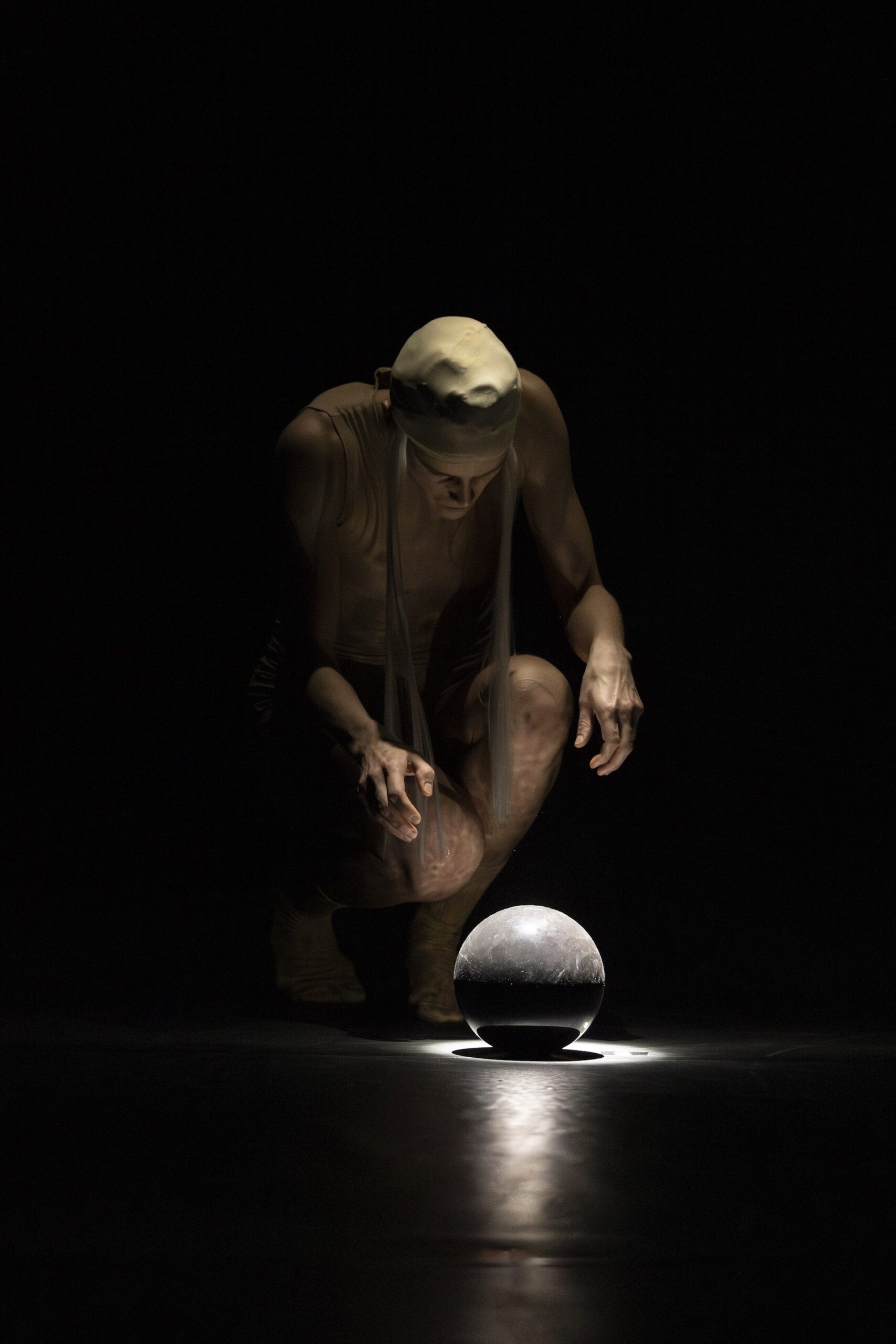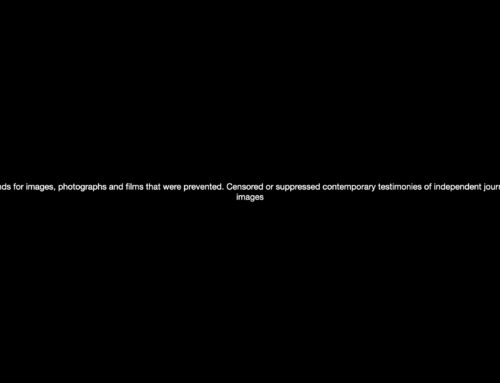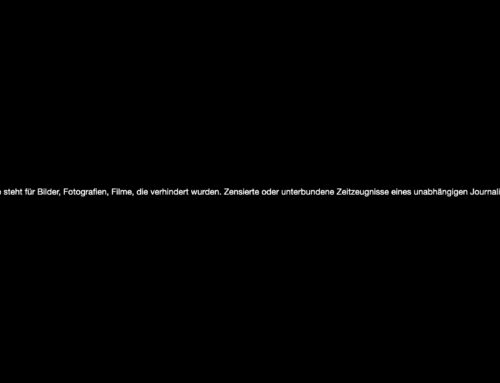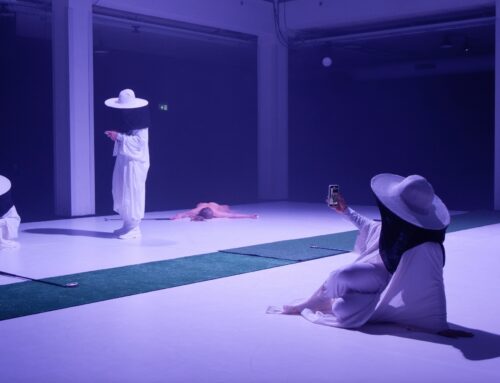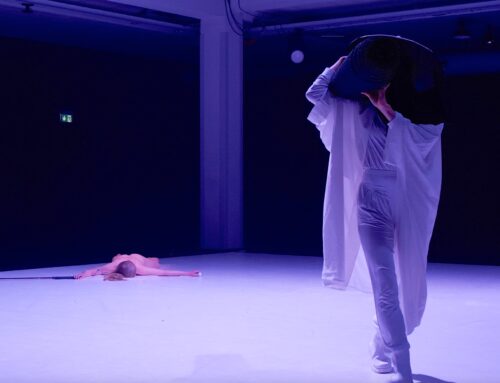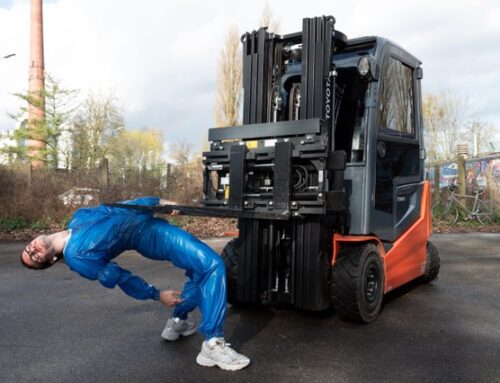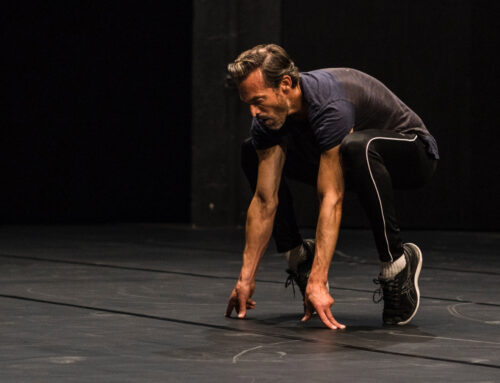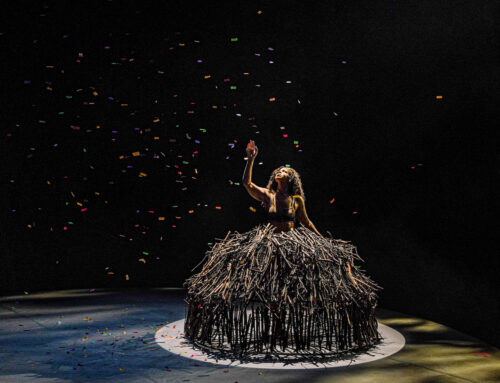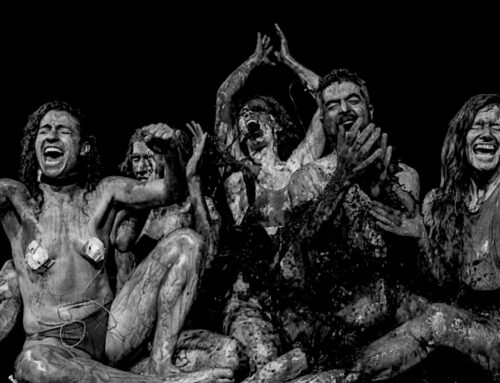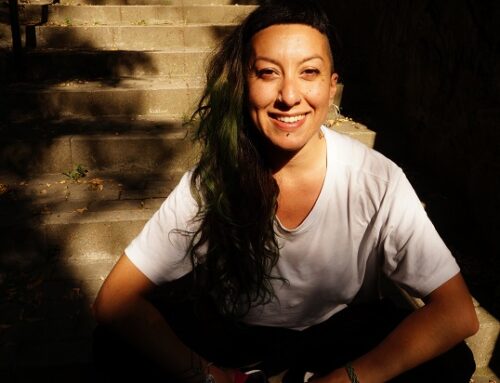A study of transience:
Gate to hell, gate to hope
Bielefeld Theatre presents Dunja Jocić’s „The Gate“. Powerful images create a sombre message: the abyss is within each of us.
By: Harff-Peter Schönherr
You who enter here, abandon all hope! This is what is written on the gate to hell in Dante Alighieri’s „Divina Commedia“.
Hell also opens up in Dunja Jocić’s „The Gate“. And hell is everywhere: the huge gate, which towers before us like a narrow gorge, surrounded by fog and darkness, occasionally pierced by glaring white light, does not lead from one world to another, it turns in front of us, circling the action on stage, without a back and without a front, without an inside and without an outside, it turns and turns, inexorably, without beginning and without end.
Two enormous monoliths form it, like bunker towers, pierced by iron bars. It seems unapproachable, frightening, mystical. If it does not drill blinding lances of light into the darkness, pale horror follows it. With unrestrained massiveness, it obscures the view, oppressively chopping up the scenes that surround it. Sometimes there is nothing to be seen but itself, as if all life had been extinguished.
The beings that move in front of this gate, and behind it, and within it, are beings of agony. They tumble and writhe, hold and lift themselves, limp and crawl, convulse spastically and become half animal and half machine, they choke and kick each other, they try out roles, feel each other in disbelief, desperately and searching, as if they are not sure who they are. In the end, they lose the last remnants of their individuality and merge into a collective, into a twitching knot of naked, uniform bodies.
While nature can still be heard at the beginning, the sea, the calls of birds, at the end there is a shattering boom, roar and rumble. In between, hard, rhythmic beats, hypnotising spherical sounds, hymn-like heavy choirs, shrill, splintering screeches. This is fierce.
In „The Gate“, Jocić deals with man’s search for himself. But this search remains without finding, ends in alienation. Couples meet, wear each other out between attraction and defence, fight each other. They tire, they succumb. It doesn’t have to be like this, but it is. In the end, everyone carries each other to the end of their lives, again and again, as if
inwardly into the grave, and the path into the light seems uncertain, is perhaps only a deception. The closer the events come to their end, the more nightmarish they become. It is dark. Disturbingly bizarre. And highly symbolic.
At times, what we encounter here seems like a ritual act, like an archaic temple sacrifice. And when the hour or so that „The Gate“ lasts is over, images from John Boorman’s post-apocalyptic fantasy vision of the future „Zardoz“ come to mind, with its monumental stone-headed deity, and from Francis Ford Coppola’s Vietnam War blood orgy „Apocalypse Now“, in which The Doors conjure up „The End“ when Colonel Kurtz dies at the hands of Captain Willard’s machete, as an apologist for horror.
At times, the actors seem like sculptures, standing and moving as if chiselled, and this also depersonalises them. At times their faces are distorted as if in pain, as if screaming. It is about inner turmoil, about control and loss of control. Sometimes, often only for a moment, hopefulness flares up. Through a look, a gesture. But it doesn’t last. Perhaps because no one believes in them. Perhaps because no one believes in themselves. Perhaps because no one has the courage not to want to be like everyone else.
The dancing and acting are top-class. The company performs strong solos and pas de deux, shows cohesion as an ensemble, demonstrates expertise in elements of classical ballet as well as in contemporary movement language. Eruption is paired with deceleration, weightlessness with groundedness, driving force with pause. Energy is shared, a sense of space, passion, subtlety, an understanding immersion in the role.
These are powerful images. It is not clear that Jocić’s „The Gate“ is reminiscent of Yugoslavian monuments „created in honour of all victims of the Second World War“, as the programme booklet assures us, nor of „the brutalist architecture of the large suburban settlements of her native Belgrade“. Nor does it convey that the Serbian-Dutch choreographer wants to thematise transhumanism, the fusion of humans with artificial intelligence. These conceptual assertions would not have been necessary: „The Gate“ is moving even without them. Sometimes an intellectual superstructure makes sense; here it does not. What we see are states of mind, the projection of power. Both are as timeless as they are universal.
The fact that Jocić integrates rhythmic gymnastics and has the actors handle balls is also irritating. Sure, Jocić was once a gymnast, even a member of the Yugoslavian Olympic team, and is „very happy to incorporate an element from my past“. But it does her choreography no favours. The balls look like foreign objects, even if they are partly reminiscent of globes.
It makes sense that set designer Stefanie Grau cites Auguste Rodin’s scenically opulent bronze „Gates of Hell“, an illustration not least of Dante’s „Inferno“ from the „Divina Commedia“, as the inspiration for her abstract, minimalist monolith gate. However, the fact that the actors are showing poses by Rodin, poses of powerlessness and despair, of rebellion, of fear, is only apparent to those who know the gate on which the sculptor worked for more than three and a half decades. The programme booklet would have done well to show more than just excerpts.
What will be remembered of „The Gate“? Apart from the gate itself, in front of which each of us stands throughout our lives? And the light that suggestively models bodies out of the darkness? And Hampus Larsson, whose physical discipline and giant-like stature make him an ideal statue? That each of us carries our own hell within us – but perhaps also our own salvation.
Jocić confronts us with great hardships. But it does not leave us without hope. Both can open our eyes. Now it is up to us to act. The abyss calls to us, insistently. We do not have to follow this call.
Further dates: 30.3., 4.4., 14.4., 16.4., 21.4., 2.5., 17.5., 21.5., Theater Bielefeld (Stadttheater), Bielefeld




